As previously mentioned, I’ll be taking the Burnley & Trowbridge brunswick workshop in May. Of course, I had to immediately scour my sources to find information about this garment, which until about 2 days ago was a relative mystery to me!
Aileen Ribeiro, in Dress in Eighteenth-Century Europe, writes that a brunswick or “German Habit” was, “A long-sleeved version of the sack, usually three-quarter-length and with a high neck and a buttoned, unstiffened bodice…. widely worn in Germany in the middle of the century” (146). Colonial Williamsburg’s glossary of colonial lady’s clothing says a brunswick is, “A three-quarter length jacket worn with a petticoat, the Brunswick was an informal gown or a traveling gown. It had a high neck, unstiffened bodice that buttoned, long sleeves, and frequently had a sack back (loose pleats) and a hood”; while a jesuit is, “Similar to the Brunswick, but the skirt of the gown was full length.”
The style appears to have been most popular in the 1760s. They were cut like a sacque gown, with the full box pleats in back. The full length sleeves were made by connecting the usual elbow-length sleeves (complete with sleeve ruffles) to a separate lower sleeve. According to posts on the 18cwoman list, this was because they were made by mantua makers, who did not use the technique of a shaped long sleeve (used by tailor’s on men’s garments); the separate lower sleeve allowed the sleeve to fit the elbow. Ribeiro writes that while early sleeves had a break at the elbow with a ruffle, by the end of the 1760s that was replaced with a small ruched cuff (although it is unclear whether she means that the elbow ruffle was replaced, or whether that was dropped and the ruffle is now at the cuff) (146). According to the information provided to those of us taking the workshop, brunswicks were not worn over any skirt supports (ie side hoops or bumrolls), although I have found one image (below) of what is probably a jesuit worn over side hoops. It appears that most are high necked, although at least one of the confirmed brunswick images (Sophia Pelham) has a lower neckline; there are other possible brunswicks/jesuits with low necklines as well below.
Barbara Johnson’s Album includes two relevant fashion plates, one of each style. The brunswick has military-esque folded back revers with buttons. The jesuit is very similar, except for a longer length overskirt. Both have the usual petticoat ruffle and loopy-patterned ruches that you’d expect to see on a 1760s sack, as well as straight ruches along the overskirt openings. There is one swatch for a brunswick: “a Manchester Brunswick twelve yards” from 1772; the fabric is a small blue and white check, which reminds me of a modern gingham.
Here is a gallery of images of probable brunswicks or jesuits. Most of the fabrics appear to be silk taffeta or satin, although there is one cotton print.

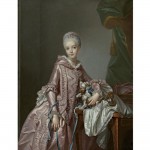
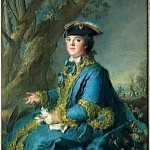
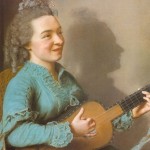

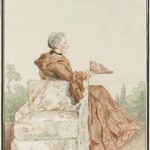
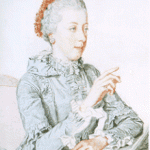
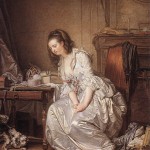
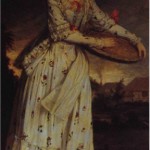
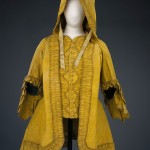

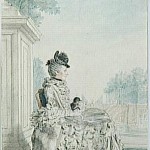

Oh, how interesting! I particularly like the “Roslin” portrait. I’ve never heard of this clothing item, so I really enjoyed the post. Can’t wait to see what you all produce from the workshop!
Ok, I feel better about not signing up for the the class now — interesting stuff, but I am confirmed in my suspicion that this is not a garment to yank my proverbial chain 🙂 Thank you soooo much for this research!!!!
Trystan – ha, no problem! Glad I helped you get over your temporary craziness.
The “Lady Mary Fox” portrait was replicated, I believe, in Dangerous Liaisons. Michelle Pfeiffer’s character wears it when she discovers Valmont with the prostitute.
Also, 18th-c. hoodies, hee!
Ten thousand times thank you ! I have been searching for the name of this type of garnment for ages and haven’t found anyhthing.
There is a similar dress at the Nordiska Museet : it’s here on Flickr : http://www.flickr.com/photos/30432726@N05/2853070300/in/set-72157607264971777/
Colonial Williamsburg’s millinery shop has made a blue and white checked Brunswick. There are photos of it on their facebook group (Marget Hunter’s Milliners) and I assume Janea will bring it to the Burnley & Trowbridge workshop as well. I believe it’s made up in silk, which certainly has an odd appearance when you’re used to associating gingham with Dorothy and the Wizard of Oz.
You are so made of awesome -I hadn’t seen half those images! I thought about making one a few years ago but never did, it’s creeping back up my do-to list now. :> I believe there is one in Barbra Johnson’s Album too.
Wow! Thank you for posting this information, I have only seen one of those portraits before. I originally got hooked a few years ago when I saw them at the Tidens Tøj museum website.
I am so jealous – you people in CA get all the good stuff! 😉
http://tidenstoej.natmus.dk/periode1/dragt.asp?ID=57
http://tidenstoej.natmus.dk/periode1/dragt.asp?ID=58
Andrew – you’re right! I can’t find a picture online, but I can picture it in my head. I’ll have to go back and rewatch that scene!
Heileen – that’s an interesting dress! No hood is visible (or in the description), but the detachable sleeves suggest this style.
Eliza – sounds like it’s an attempt to make up the dress Barbara Johnson swatches in her album, as that’s the fabric! I do like knowing it’s silk though — because you’re right, it totally reads as 19th/20th century.
Noelle – ooo, good reminder on those two! I love the pink one. And don’t envy us in California — when it comes to 18th century, we’re usually envying those on the US east coast or in Europe! You guys have all the museums/workshops/fabulous period buildings and events. Sob. SOMEDAY I TOO WILL GO TO VAUX-LE-VICOMTE!
Oooh. I’m beginning to be sold on 18th century. Not only it’s 18th century hoodie, as Trystan pointed out (I like how it looks loose and comfortable), it’s also German, and German surely means it was also probably worn in Bohemia, and I’m from there, so…
Well, generally I always love seeing something else than French or English fashion for a change. 😀
I have to add something : some polonaise dresses of the 1770s had a hood, called a coqueluchon, so some of the low necline dress you posted may be this kind of polonaise and not Brunswick/jesuite
Heileen — interesting! Thanks for the info/warning. I’ll have to look into coqueluchons!
Voyez! Mules à fleurettes, fichus et coqueluchons!
Here’s a doll wearing a reproduction of the checked Williamsburg brunswick: http://www.susanparrisoriginals.com/
Am I crazy for wanting to make a quilted one like the yellow Danish?
Katherine — you’re crazy, but in the best way!
IN BRIGHT SCREAMING PINK.
Go ahead, call me a Peep. Am I one of your peeps? ;p
Katherine: Of course you are, but if you make a BRIGHT SCREAMING PINK brunswick, I think you’d be a literal peep! (You should put peeps in your wig!)
If you come across information on coqueluchons, would you mind posting about it in a way similar to this post? I am IN LOVE with the rose dress by Rokotov and am determined to recreate it at some point, but I’m not nearly as experienced with 18th century sewing as you are. Any guidance you can give would be GREATLY appreciated.
Kendra
I looked at the V and A Brunswick with Jean Hunnisett a good few years ago. Unfortunately I can’t find pictures (old camera – prints!) but I remember her thinking that it had been altered – the hood really didn’t work well at all, and might well have been an afterthought, in her opinion. That might explain the lack of sleeve extensions. They are currently moving the costume store to a better (?) facility, which time I shall go and have another look, if you like. However, it could be some time.
THANK YOU, THANK YOU – Having the artist’s name and the date is VERY helpful.
I have noticed that on Roslin’s painting the hood is attached to the waistcoat. Do you think it was possible that a lady in 18th cenutry had 2 dresses in 1? Or that jesuit dress was altered robe a la francaise? Because that dress from the painting could be easily worn as robe a la francaise if the waisticoat was replaced by stomacher and the sleeve extensions removed. I’m just wondering…
Good question! I don’t think anyone knows for sure, but it’s definitely an option. When I took the Brunswick workshop from the Colonial Williamsburg head mantua-maker/dressmaker, she had made one that way and offered it as an option.
Thank you so much for posting this information! I was trying to figure out what was up with this dress http://sartorialadventure.tumblr.com/post/150599356421/portrait-of-elizabeth-burdett-d1807-daughter , since it was masculine and looked like a riding habit but had a sacque back, which I didn’t think habits did. But it has the ruched cuff at the elbow exactly as Ribeiro describes.